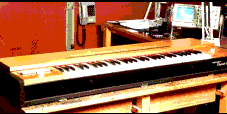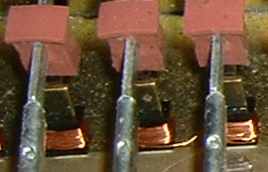|
 © ©

Restoration & Service | 
| ||||||
| The Clavinet.
Clavinets are among our favourite small keyboard instruments and the only one I have personally owned for home use. We have enjoyed working on them since the '60s. Owners are often surprised at how well they respond to a good service and a lot of TLC. | ||||||||
 A D6 model in our Mercia workshop.
A D6 model in our Mercia workshop.
The Clavinet was created by Ernst Zacharias & introduced by Mattheus Hohner in 1964. It is a form of clavichord, smaller and more portable than the classical instrument. Diminutive in size, but not in sound.
Two pickups allow amplification, the first model had a built in amplifier & speaker. Apparently originally designed for classical music, fate decided its future lay elsewhere. Its potential was quickly realised by a numner of popular musicians. In particular, Stevie Wonder brought it to prominence.| Home |
| Moog |
| Hammond |
| Rhodes |
| Wurlitzer |
| Clavinet |
| Leslie |
| VOX |
| ARP |
| Sequential |
| Oberheim |
| Roland |
| Yamaha |
| Korg |
| PPG |
| Various |
| Harmony & Tuning |
| Rogues' Gallery |


 The last model in the Pianet range, a more modern style.
The T uses non-sticky pads to pluck its reeds, relying on suction.
The last model in the Pianet range, a more modern style.
The T uses non-sticky pads to pluck its reeds, relying on suction.
 With its top removed, to show the mechanism & reeds. The T model is the only Pianet with magnetic pickups & has no internal electronics.
With its top removed, to show the mechanism & reeds. The T model is the only Pianet with magnetic pickups & has no internal electronics.
 Close up, showing reeds, with their mounting bosses.
Close up, showing reeds, with their mounting bosses.
 'Plucking' pads on the rear of keys & the individual magnetic pickups under the front tip of reeds.
'Plucking' pads on the rear of keys & the individual magnetic pickups under the front tip of reeds.

 The Dulcitone was designed in 1860 by Thomas Machell & Sons of Glasgow. As far as I know it remained in production until the 1920s. My experience of this instrument was in the mid 1960s, when I overhauled an early one for a friend.
The Dulcitone was designed in 1860 by Thomas Machell & Sons of Glasgow. As far as I know it remained in production until the 1920s. My experience of this instrument was in the mid 1960s, when I overhauled an early one for a friend.


